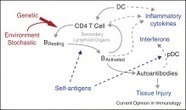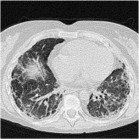The pathogenesis of systemic lupus erythematosus—an update
Jinyoung Choi1, *,Sang Taek Kim1, *,Joe Craft1, 2,
1 Department of Internal Medicine (Rheumatology), Yale School of Medicine, New Haven, CT 06520, United States2 Department of Immunobiology, Yale School of Medicine, New Haven, CT 06520, United States
http://dx.doi.org/10.1016/j.coi.2012.10.004,
Systemic lupus erythematosus (SLE, lupus) is characterized by a global loss of self-tolerance with activation of autoreactive T and B cells leading to production of pathogenic autoantibodies and tissue injury. Innate immune mechanisms are necessary for the aberrant adaptive immune responses in SLE. Recent advances in basic and clinical biology have shed new light on disease mechanisms in lupus, with this review discussing the recent studies that offer valuable insights into disease-specific therapeutic targets.
The pathogenesis of systemic lupus erythematosus—an update [Current Opinion in Immunology—an update] http://t.co/gKMERgRK...
Via
Alfredo Corell



 Your new post is loading...
Your new post is loading...











